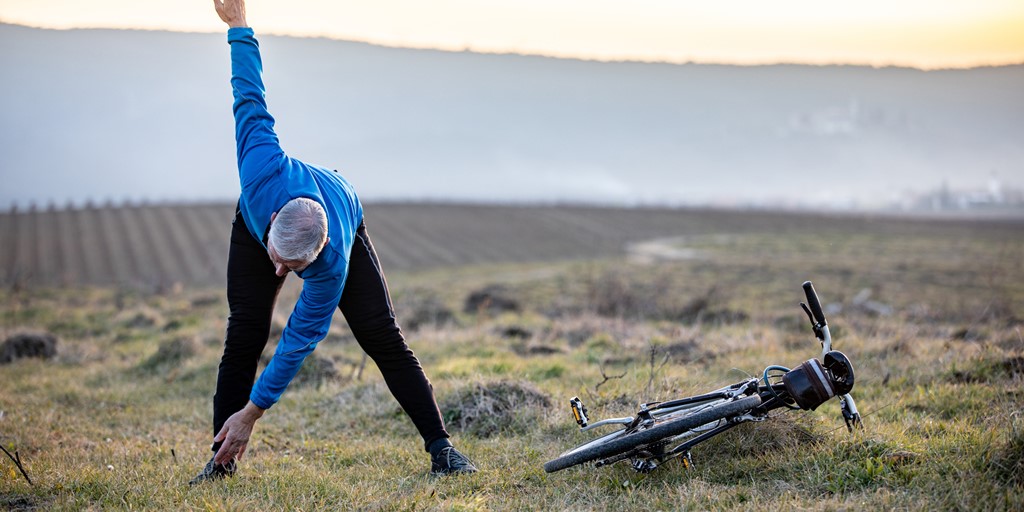The 7 best stretches for cyclists to prevent injury

Cycling stretches are important for keeping your muscles flexible and strong, and your performance in top form.
Harvard Health says that muscles can shorten and stiffen without stretching, which leads to injury. But where do you start, and what are the best stretches for cyclists?
We’ve covered the importance of stretching for cyclists, including expert insights to inspire you to follow a proper stretching routine before and after your sessions.
Table of contents:
The importance of stretching for cyclists
Injury prevention is the main goal of performing pre and post-cycling stretches, alongside keeping your muscles in great condition to reach your personal goals.
But it can be difficult to structure warm-up or cool-down routines if you haven’t done so before or if you don’t understand their benefits.
Let’s discuss warming up first. Gabrielle Watkins, Personal Trainer at OriGym, says:
“Warming up helps to increase your heart rate and blood flow, allowing more oxygen to travel to your muscles.
“In turn, this will make the workout ahead less strenuous, as these muscles will now be able to contract and relax easily, improving your performance and decreasing the risk of injuries.”
So, what about post-cycling stretches? The effect is largely the same. But instead of preparing your muscles for strenuous activity, you’re promoting muscle fibre recovery so that your strength increases, and you can gradually push your muscles further.
Related: What muscles does cycling tone?
Dynamic vs static stretching
Dynamic stretching involves controlled movements that take a joint or muscle through a range of motion. They typically mimic the movement you’ll be performing during your workout, making them more effective for warming up.
On the other hand, static stretching involves holding a single position for at least 30 seconds. The goal is to stretch the muscle through its full range of motion and hold this position to relax it.
Since this method is more focused on promoting recovery through relaxing the muscles and removing the lactic acid that forms within them during exercise, it’s better for cooling down.
The best stretches for cyclists
Pre-cycling dynamic stretches
You should perform these cycling stretches before heading out for a session. Perform each stretch for three to five sets of 10-15 reps.
Starting position:
stand with your feet over shoulder-width apart in a position that feels stable
hold your arms out at your sides so they are parallel to the ground
How-to:
bend forward, rotating one arm towards the opposite foot
hold your position for one second once your hand touches the ground, or reaches the end of your range of motion—you should feel a stretch in your back and hamstrings
return to the starting position, and repeat with the opposite side of your body
Why perform them?
Windmill rotations activate your back, core, and lower body, and build total-body stability. They are a great introduction to your warm-up routine, as they’ll pump blood to all the key areas you’ll be using during your session.
Starting position:
stand with your feet around shoulder-width apart, your shoulders back, and your arms at your sides
ensure your head is up throughout the movement (you might find it useful to pick an imaginary point straight ahead of you to focus on)
How-to:
lunge forwards with one foot (stop at a position that isn’t too close, but also isn’t overstretching your lower body)
keeping your back straight, your head facing forwards, and your arms at either side, lower your body until your front knee is at around a 90-degree angle
put your arms straight out in front of you, and engage your core
twist your arms and head simultaneously towards the side of your body you lunged out with, stopping when your elbow is parallel to your knee
carefully retrace your steps until you’re back in the starting position, and repeat with the opposite side of your body
Why perform them?
Lunges are a great all-rounder as far as cycling stretches go, as they increase blood flow to the major muscles involved in the activity, such as your quads, calves, hamstrings, and glutes. They’re also incredible for increasing ankle, hip, and knee stability.
Torso twists complement them perfectly as they stretch out the spine, core, and obliques, and prepare them for supporting your body throughout your session.
Warming up and strengthening these muscles can help alleviate back pain associated with cycling for long periods. If they’re weak, your body will compensate by placing pressure on your lower back.
Starting position:
stand with your feet around shoulder-width apart, your shoulders back, and your arms at your sides
How-to:
keeping your back straight and your knees behind your toes, begin lowering your body (you might want to hold your arms out in front of you for stability)
pause for two seconds once your knees are at around a 45-degree angle (some people can go lower than others, but don’t overstretch)
driving your weight upwards through your heels, return to the starting position—you should feel a stretch in your glutes as you rise
repeat
Why perform them?
Squats are one of the most effective cycling stretches for promoting knee strength and stability, which is vital for cyclists. They will prepare your knees and hamstrings for being heavily activated during the pedalling action.
Starting position:
stand tall with your feet around hip-width apart, your back straight, and your arms at your sides
How-to:
hinge forward at your hips until your hands reach the ground just in front of your feet
use your hands to carefully ‘walk’ your body out until you reach an extended plank position—you should feel the pressure on your core, shoulders and biceps as you do so
hold for a few seconds, and then reverse the movement until you reach the starting position
repeat
Why perform them?
The core plays a large role in keeping your body stable whilst cycling, especially since it prevents side-to-side movement, allowing you to achieve a smoother pedal stroke.
If your core is weak or neglected during your warm-up, your body will engage other muscles to compensate, which could lead to injury or poor performance.
Post-cycling static stretches
Perform each of these stretches for three to five sets of 30-45 seconds after cycling to maximise your recovery.
Starting position:
stand with your feet around hip-width apart and your arms by your sides
How-to:
place one foot in front of the other—your front knee should be straight, and your back knee should be slightly bent
hinging at your hips, bend your back knee until it reaches a 90-degree angle—you should feel a stretch in your front hamstring
hold this position for 30-45 seconds
perform for your desired number of reps, and repeat on the opposite side
Why perform them?
Stretching tight hamstrings increases the range of motion and flexibility in the hips so that you can get back on your bike sooner rather than later after a tough ride.
Starting position:
get into a lunge position on the floor, with both knees at around a 90-degree angle
you may want to use an exercise mat or place a towel beneath your shin for comfort
How-to:
lunge forwards at the hips until you feel a stretch in your hamstring
you may want to place your hands on your hips or across your chest for balance
hold this position for 30-45 seconds
perform for your desired number of reps, and repeat on the opposite side
Why perform them?
If your hips, hamstrings, and quadriceps are tight after cycling, and you fail to stretch them, you could leave yourself vulnerable to injury. Hip flexors are one of the best cycling stretches for targeting and relaxing these muscles.
Starting position:
sit with your legs straight out in front of you and your knees together
How-to:
place one foot over the opposite knee and your hands on your outer thigh
gently push your bent knee towards your opposite shoulder—you should feel a stretch in your glutes
hold this position for 30-45 seconds
perform for your desired number of reps, and repeat on the opposite side
Why perform them?
Your lower back takes the strain for your glutes when they’re out of action. But properly stretching them reduces tightness and tension in the area and reduces the risk of injury post-workout.
Whether you’re a hobbyist or an aspiring athlete, cycling comes with its fair share of risk. This is why you may want to protect yourself and your bike through specialist cycling insurance.
At Cycleplan, we arrange cover for a range of bikes and accessories up to a total value of £30,000.
This protects you if your bike is lost, damaged or stolen, providing you report it to the police within 24 hours.
You can also opt to cover yourself for Public Liability and Personal Accident cover for complete peace of mind.
Click here to discover more about how we can help, or get an instant online quote today.







